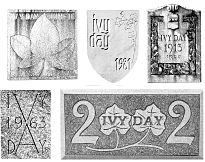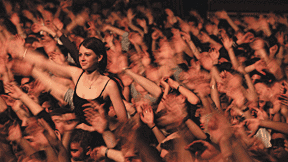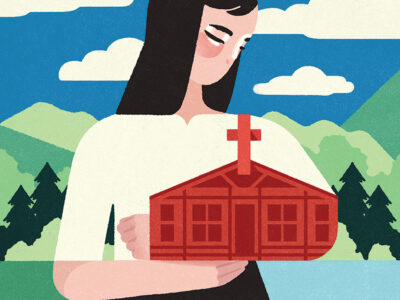Ever wondered where “Rowbottoms” came from, why they call it “Hey Day,” or what flings in the spring? Here are attempts at explanations—with illustrative excerpts—of some Penn traditions past and present.
Up through the first decades of the 20th century, the freshman and sophomore classes apparently spent a considerable amount of time fighting with each other [“Finals,” this issue]. Over time, some of these battles, which have their earliest roots in the 1860s, gave rise to the men’s senior honor awards known as the Spoon, Bowl, and Cane. Along with the more pacifist Spade Award, these are now given on Ivy Day (see below), as are the Hottel, Harnwell, Goddard, and Brownlee awards for senior women.
Other inter-class conflicts passed out of practice without leaving behind such distinguished legacies—it is probably for the best, for example, that the University does not present an annual award commemorating the Pants Fight.
Class Fights
It isn’t easy to climb a six-foot fence surmounted with spikes when you have on a pair of new blue denim pants guaranteed unbreakable, bought especially for the occasion, but very much tighter than fashion or comfort demands. But it is better to run the risk of that kind of accident than to take any chances on getting into your dormitory room through the front door when you know as sure as fate that the Freshmen are laying for you. Of course, when you do get into that first-floor open window looking out on Woodland Avenue you are not really sure in the bottom of your heart what is waiting for you. Like the boys going “over the top,” you have an uneasy sense of the uncertainties of life. But in you go, hoping that you will be able to sneak through the corridors and get up to your own room without being kidnapped on the way.
West Philadelphia in the neighborhood of the University presents many a strange sight the day of the Pants Fight. Blue pants, yellow pants, brown pants, white pants, flannel shirts, cotton shirts, khaki shirts, no shirts, running trunks, pajama coats and B.V.D.’s, every possible kind of masculine attire is sported on the Campus. In the Quad, where their imprisoned brothers await them behind drawn curtains, boys are pulled up by the hands into the Dormitory windows. On Locust Street, on Woodland Avenue, daring burglaries are committed in full daylight. Boys scramble into first-floor windows, second-floor windows, even miraculously into the third-floor windows of all the Frats, while bewildered women stand on the street corners and wonder what the poor dears are doing to each other.
“It’s really distressing,” says a gentle-voiced colored woman as a howling mob sweeps up Locust Street, breaks into Delta House, searches the rooms, opens the closets, looks under the beds, and emerges triumphant with one lone Sophomore. Destiny at that moment sends along a water wagon. The Soph is properly drenched and, having expiated the sin of being a Soph, he beats it back home with the shreds of his dignity and his underwear huddled about him.
All day long classes have been cut without remorse. All day long it has been dangerous for Sophomores or Freshmen to travel alone.
“Get ready for the Big Fight,” say the posters. “Pants Fight” in Franklin Field at 4:30. At 4 o’clock the tension heightens. Down the street comes a distant and confused murmur. The Sophs appear en masse. They know as sure as fate that against the onslaught of the “Freshies,” a handful of Sophs can never hope to keep the three pairs of pants that the rules require for a victory.
Like Christian martyrs in the arena, the little band faces the enemy like men. In single file the Sophs walk around the track and approach the center of the field. A phalanx forms around the president, face outward, arms locked in arms. A pistol shot is fired. The Freshmen advance in a huge circle. They buck the line. They break the line. The victory is complete. Even the manager of a Greek gymnastic team would be satisfied with the costuming. The dust arises thick and yellow and veils the scene.
In the Dorms shower baths are in great demand. In an hour well-bathed, well-combed, well-dressed young gentlemen swarm to dinner. The Pants Fight is over.—“The Pants Fight,” by Beulah B. Amram, May 30, 1919
Ivy Day
Ivy Day has been celebrated since the University moved to the present campus in West Philadelphia. Starting with the graduating class of 1873, classes have planted sprigs of ivy, and “ivy stones” commemorating the graduating classes have been set into University buildings and other locations. From 1926 through 1961, men and women’s classes placed separate ivy stones. Senior honor awards are also announced on this day.
Once a part of Hey Day (or Heyday), the ivy ceremony was transferred to the Saturday before Commencement in 1981. This was actually something of a return to tradition—the ivy planting and ivy stone dedication had formerly been part of Class Day activities that took place on campus the day before Commencement, which until 1922 was held off-campus.
The Ivy planting exercises of the Class of 1903, University of Pennsylvania, took place Monday afternoon on the campus of the university. The senior class and a number of underclassmen and friends of the graduates assembled at the northeast corner of the old College Hall, where the decorative tablet, which denotes by which class the ivy is planted, had been let into the wall of the building.
The exercises were opened by the reading of the ivy poem by William B. France, after which the ivy was planted by Frank van H. Slack, the Spade man of the class. Henry C. Diller delivered the ivy oration, in which he pointed out how the ivy of all the classes, having its root in common soil, covered the Alma Mater and that the various classes received their inspiration from a common source, showing further that the planting and building represented the activities of the college man’s life, and that he built and planted not on the past, as indicated by his life at the University, which was then ended, but by the future in which his work will bear fruit. By keeping in close touch with the Alma Mater it would gain strength and inspiration from the University, where all had spent four of the most vital years of their life.
After the oration the exercises closed with the singing of a number of the college songs by the senior class.—“The Ivy Planted,” June 20, 1903
Another tradition of longstanding bit the dust this year when the Ivy Day ceremony, since its inception a male-only affair, became coed. Ivy Day, the unveiling of the Ivy stone and the planting of the ivy which symbolizes the graduation of the senior class, began in 1873. It was entirely all-male until 1962, when the men and women together presented the stone; the men planted the ivy the following day. This year the ceremony went coed.—May 1963
Amidst a rash of racist incidents on campus, the University last month held a rally and issued statements for tolerance and unity.
The steps followed a series of telephone calls to the W.E.B. DuBois College House, which conveyed bomb threats. Earlier this semester, vandals tried to remove the Class of 1981 Ivy Stone from the wall of DuBois House.
The rally attracted over 1,000 people, many of whom marched, with arms linked, from the peace sign in front of Van Pelt Library to the Superblock area outside DuBois House, where they heard—along with a racial slur yelled from afar—pleas for unity and an end to intolerance.—November 1981
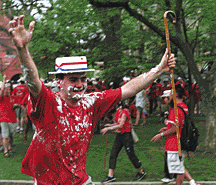
jjtiziou.com
Hey Day
As currently celebrated, Hey Day takes place on the last day of classes and marks the official advance of the junior class to senior status. Students carrying miniature bamboo canes and wearing Styrofoam “straw” hats and—in a bow to more contemporary fashions—souvenir T-shirts march from the Junior Balcony in the Quad down Locust Walk to College Hall, where they are greeted by the president. The canes are a relic of the “Junior Cane March,” originally a fall event, which was incorporated at some point after the mid-1950s.
In a recent innovation (possibly as of this year?), marching juniors squirted various sticky substances—whipped cream, caramel, chocolate sauce, silly string, etc.—on each other during the march. They seemed to enjoy it (more than the spectators, anyway).
After weeks of preparation, Ivy Week is over. The action of numerous committees that culminated in this gala week-end helped to make this celebration time the most looked-forward-to time of the year.
The first official part of the program was enacted on the historic Hey-Day, at which time the Spoon, Bowl, Cane and Spade awards, symbolic of senior honor in the order named, were presented.
Hey-Day was climaxed by the Ivy Ball at the Penn Athletic Club. Twelve hundred couples swayed to the combined efforts of Don Redman and Ted Fio Rito in a wonderland of Red and Blue decorations. Notables from the Mask and Wig cast performed in an inimitable style, entertaining the dancers with a variety of songs and dances. A professional floor show provided more entertainment during the intermission. The undaunted efforts of the Committee were rewarded in that the dance was a huge financial success as well as bringing pleasure and enjoyment to hundreds of dancers and House Party guests.—July 1, 1936
To the Editor:
I am aware of the extent to which time can distort and erode the truth. But I was particularly startled to read that “Hey Day, the time when senior honors and awards are conferred, dates back to the nineteenth century.” Spelled as it should be, Heyday actually dates back only to the senior year of my own Class of 1916 and my then tenure as editor-in-chief of The Pennsylvanian. For many years prior to that, the principal spring celebration for undergraduates had been “Straw Hat Day,” the special event always being a baseball game with Princeton. On Straw Hat Day, students, with rare exceptions, appeared in straws, usually brand new sailors, with a sprinkling of Panamas for the more affluent. In fact, Straw Hat Day was so widely accepted that in the whole of the Philadelphia area no one dared to wear a straw hat before that day, and then all males who could afford it broke out the new headgear.
Heyday, by that name, came about as a result of a sort of pun. I had become well acquainted with the word heyday because one of my favorite professors, Dr. Cornelius (Corny) Weygandt of our distinguished English Department, in the course of his lectures frequently spoke of the heyday of someone’s literary career. In an editorial in The Pennsylvanian, I therefore suggested, half-facetiously, that Straw Hat Day be known henceforth as Heyday and that the then scattered events of importance be concentrated in one day, which would represent a sort of apogee or heyday of college life and activities.
To my great surprise, the general idea of Heyday somehow caught on.—Eugene H. Southall C’16, July 197
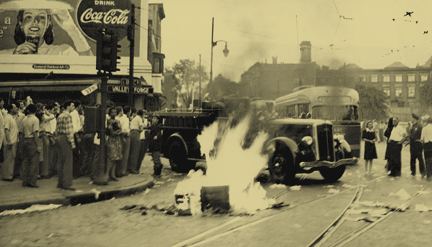
Rowbottom
Some details of its origins are disputed, but from before the First World War through the mid-1960s, the call Rowbottom! was synonymous with, as one admiring writer put it, “any rowdy gathering or grand scale riot.”
I was a resident of the Dormitories when this thing started. Various friends of Rowbottom including his roommate would show up in the Triangle at any hour of the evening either late or early to call him to the window. All the winter of 1909-1910 these calls made little comment, but when the spring came and we were deep in study it got to be a nuisance. Some of the rest of us would stick our heads out and in no uncertain terms tell the caller to shut his mouth up. The men in the rooms began to enforce the argument by throwing missiles at the callers and burnt out bulbs and other articles found their way out to the sidewalk. Then as examination time came in the spring of 1910, and when a fellow had been grinding into the early morning hours, it got to be the custom of anyone who felt in the mood to go to the window and bellow out “Yea Rowbottom.” It seemed to relieve the tedium of hot weather study hours. The effect was certain and instant. Everybody would go to the window and add his bit. After a few minutes there would be a general discharge of missiles from the windows, including anything loose, and various room crockery with which the rooms were furnished. These affairs would happen about once a week all the spring of 1910 and were the first of what have proved to be and were then very annoying to the authorities. I thought this exact description of the first Rowbottom by an eyewitness would be of interest to you.
—Arthur W. Marriott, October 15, 1934
Pre-Army game fervor generated high spirits on the campus. When one leather-lunged student cupped his hands at 37th and Woodland Avenue about 8 p.m. on November 14 and roared “Rowbottom,” official warnings after an earlier evening were forgotten or ignored.
The pattern was as usual. An estimated 4000 young men and women lit bonfires, pulled trolley poles, pushed automobiles from their parking places, and went though other evolutions of a like nature.
Firemen were called and promptly found such property as helmets, axes, hose connections, and other paraphernalia disappearing in all directions.
When a PTC emergency crew mounted to the top of a trolley car to repair a cut rope, students stole their ladder, then pelted them with vegetables and eggs.—December 1946
To the Editor:
In the January issue I found a necrological listing that at first made me smile and then made me very sad. The listing was simple. A mere line …
’12ME. Joseph T. Rowbottom, Mineola, N.Y.
I have read many articles in the Gazette about deceased teachers and alumni; many of them people I, for one, have never heard of. But here we have a name that means more to generations of undergraduates than a graveful of Hopkinsons, Biddles, and Bodines. A name that conjures up more memories of mischief, mayhem, and pure joy than any other.
The true story, or so I was led to believe as a very green, bedinked freshman, was that Rowbottom, a quiet peaceful soul, lived on the fourth floor of Memorial Towers with a noisy drunk of a roommate. Almost nightly, the roommate would come home “highballed” and yell for Rowbottom to help him up the stairs. Eventually the call “Rowbottom” not only aroused Rowbottom but woke other students who angrily threw bottles, shoes, and anything else they could find. And from such a little beginning a Penn legend was born. Since then, any rowdy gathering or grand scale riot was called a “Rowbottom.”—Allan D. Moskowitz C’59, March 1963
To the Editor:
In the fall of 1908 and the spring of 1909 I roomed in 32 Memorial Tower, one floor below “Tubby” Rowbottom. Harger Bliss W’10 was my roommate.
Tubby did not have a drunken roommate, in fact he may not have had any. He did have a friend who did not live in the dormitories. Not seeing any sense in walking up three flights to see if Tubby was in, he would let out a “yea-a-a Rowbottom.” That was all there was to it.
However, come the spring of 1909 some dude in the dorm about half way between the Tower and the Little Quad, stuck his head out the window, yelled “yea Rowbottom” and tossed out a “thunder mug” (slop jar). It made a beautiful booming sound. Needless to say, the original “Rowbottom” was on.
The above named roommate of mine became so enthusiastic that he heaved out a mug before opening the window. He paid for the window but I paid for the mug. (Bursar’s bill dated May 3rd, 1909 for $1.52, in my scrap book.)—J.H. Bell W’12, October 1963
Rumors of an impending Rowbottom reached the Office of the Dean of Women in mid-April. The dean, Alice Emerson, pondered how to head off the traditional rite of spring. She had a brainstorm: why not give the young men another outlet for their energies? She quickly organized a dance at the women’s dormitory and invited all University undergraduates. A full-fledged Rowbottom was thus averted, although the mere march of the male students to the dorm did require police surveillance. Officers kept order until the boys filed into the dorm and vented their energies on the Watusi and the Swim.—May 1967
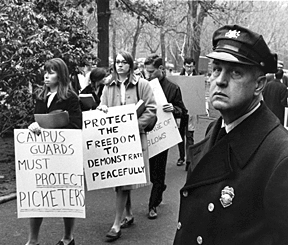
Sitting-in at College Hall
Around the time that the Rowbottom was dying out, students turned their attention to a new ritual more in keeping with the mood of the day—sitting in at College Hall. As in the country at large, this activity peaked at Penn in the late 1960s-early 1970s, but there have been memorable revivals at intervals ever since.
The first College Hall sit-in was in 1967 and involved protests over biological-warfare research projects being conducted at the University; the most recent was a nine-day occupation of the building in early 2000 by a group protesting the use of sweatshop labor to produce school-logo merchandise. Besides the Vietnam War, other issues have included better campus security against rape and to establish a women’s center on campus (1973) and to protest budget cuts and tuition hikes (1978).
On April 24, a group of students calling themselves STOP (Students Opposed to Germ Warfare Research) held a meeting at the Christian Association and decided to hold a sit-in inside College Hall two days later. On April 26, 50 or so students of STOP calmly ascended the steps of College Hall. The sit-in was originally scheduled from noon to 5 p.m. but it actually lasted for the rest of the week, until 5 p.m. on Friday.
On Wednesday evening, the students studied, watched a portable TV that someone had brought along, typed term papers, and discussed foreign policy. The Christian Association coffeehouse, the Catacombs, supplied coffee and the campus guards on duty became spectators to several bridge games. A reporter from a local paper had everyone pose in sleeping bags for the early edition. When the 11 o’clock news came on, all 60 protestors crowded to the reception room of the president’s office to boo and cheer alternately the coverage they were getting. Dean of Women Alice Emerson had, incidentally, given the girls involved permission to spend the night in College Hall.—May 1967
It was past noon on Thursday, March 2, several minutes after a rally on the steps of College Hall, at which about 1,200 students gathered to protest budgetary measures—both fiscal cuts and a tuition hike—which they felt had been thrust upon them by the University administration. Some students seemed surprised to find themselves inside the building; a take-over apparently, had not been planned. But many in the rally crowd came in, jamming the College Hall corridors.
Meanwhile, members of the Black Student League began a sit-in in the Franklin Building. The members of the Black Student League were joined by other students in an attempt to show, as student leaders were eager to say, that student demands were not oriented on racial lines. Various minority groups formed a caucus—the United Minority Council—which became incorporated into the terms of the final sit-in agreement.—April 1978
Spring Fling
Since its inception in 1973, Spring Fling has developed into the major student celebration of the year. Held over the third weekend in April, it includes a wide variety of food, games, and entertainment in the Quad, and a major concert, held these days in Hill Field. As near as we have been able to find out in an admittedly hit-and-miss search through our back issues, the Gazette has printed not a single word about Spring Fling. To make up for that oversight, we sent photographer and Class of 2002 graduate Jacques-Jean Tiziou (jjtiziou.com) to record this year’s festivities.


